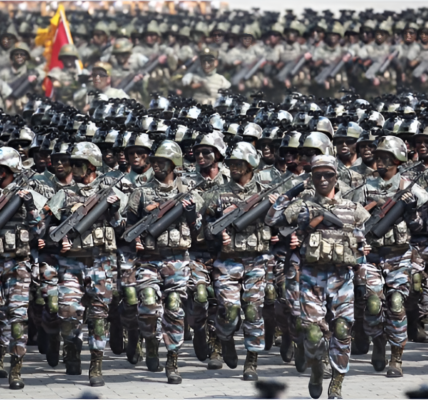
In 1924, the U.S. Army Industrial College opened its doors to tackle the lessons learned from World War I, where mobilizing the American economy for war proved a serious challenge. Seventeen years later, the U.S. found itself embroiled in World War II, and the Army Industrial College became a key contributor to the economic mobilization efforts that helped secure victory. A century after its founding, however, the lessons from those earlier days of mobilization have largely faded, and a new generation of military planners finds itself urgently needing to revisit these teachings.
In today’s security environment, defense planners are often focused on preparing for short, sharp conflicts—visions of rapid, technologically advanced engagements. But these assumptions are dangerous, as they overlook the complexities of a protracted great-power conflict. The United States needs to rethink its approach, particularly in relation to its industrial base and supply chains. After decades of de-industrialization and reliance on global trade, the U.S. military’s ability to sustain advanced platforms and technologies in long-term conflict is at risk. Close cooperation with private industry is essential to understand and prepare for the resource requirements of a prolonged war, one where global supply chains may collapse under pressure.
The Illusion of Short Wars
As World War I erupted, Kaiser Wilhelm II famously promised his soldiers that the conflict with France would be over by Christmas. Yet, as historians like Robert Gilpin and Cathal Nolan have pointed out, wars between great powers tend to drag on, evolving into contests of attrition. Today, as the U.S. faces the potential of conflict with China, the same patterns may emerge. Despite China’s preparations for a swift strike on Taiwan, the historical trend of protracted great-power wars suggests that such a conflict could last much longer than expected.
Both China and the U.S. have significant political incentives to continue fighting, even in the face of devastating losses. The question for U.S. military planners should be: How can we prepare for a conflict that may extend far beyond the initial stages, and how can we sustain our forces and resources for the long haul?
The Challenge of Advanced Technology and Sustainability
The United States has long enjoyed military-technological superiority, a result of decades of research and development that culminated in highly advanced platforms and weapons systems. However, while these technologies are incredibly effective in the early stages of conflict, they come with vulnerabilities. In previous engagements, such as the Gulf War and the War on Terror, U.S. military technology was not fully tested in a high-intensity, prolonged conflict. But the reality of war is that it eventually tests not only strategies and tactics, but also the ability to sustain operations over time.
The F-35 program, for example, relies on a just-in-time supply chain that could falter in a protracted war. Similarly, the ongoing Russo-Ukrainian war has exposed the difficulties that Western defense companies face in replacing lost materiel quickly enough to keep up with the attrition rate. As modern technologies like hypersonic missiles and underwater drones are introduced to the battlefield, they require critical materials—such as tantalum and bismuth—that are not readily available within the United States.
If the U.S. struggles to maintain basic supplies for current conflicts, how will it manage the complex systems required for a high-tech, large-scale war with a competitor like China?
The End of the Arsenal of Democracy
A common assumption is that the U.S. could mobilize its economy in the same way it did during World War II. At that time, the U.S. was the world’s largest manufacturer, with an underemployed workforce ready to pivot to wartime production. The current reality, however, is far different. De-industrialization and globalization have significantly reduced the U.S.’s manufacturing capacity. Once vital sectors such as forging, foundries, and machine tools have diminished, with many industries relocating overseas in search of cheaper labor.
Manufacturing jobs, once a cornerstone of the U.S. economy, have plummeted from 34 percent of the workforce in 1950 to just 9 percent today. This shift, accelerated by globalization and the rise of multinational corporations, has created a dangerous reliance on global supply chains that are increasingly vulnerable to disruption.
As a result, there is no longer an “arsenal of democracy” ready to be ramped up at a moment’s notice. The U.S. can no longer count on a vast, untapped industrial base to quickly scale production for war. Instead, the country must face the reality that its ability to wage prolonged conflict depends not only on military technology but also on rebuilding a resilient industrial base that can support it.
A Call for Action
The United States faces a critical challenge. If it is to successfully navigate a prolonged conflict with a peer competitor like China, it must recognize the limitations of its current industrial base. Relying on advanced technologies, complex global supply chains, and the hope of quick victories will not be enough. Defense planners must understand the importance of building a sustainable, resilient industrial base that can support the military for the long haul.
This requires strategic investments in domestic manufacturing, enhanced collaboration with private industry, and a renewed focus on the vulnerabilities that modern global supply chains introduce. If the U.S. is to maintain its military edge in future conflicts, it must not only modernize its armed forces but also ensure that its industrial base is prepared for the demands of a prolonged war. The lessons of the past, particularly the legacy of the Army Industrial College, provide valuable insights into how the U.S. can rebuild and strengthen its industrial foundations, ensuring that it is ready for whatever challenges lie ahead.




